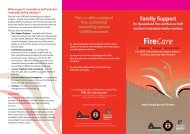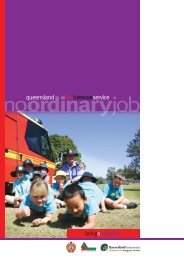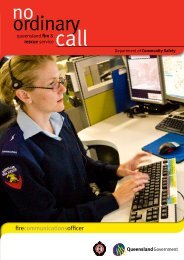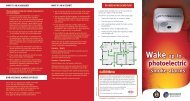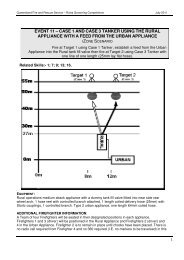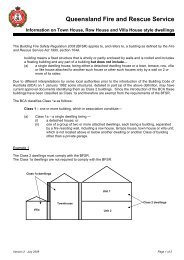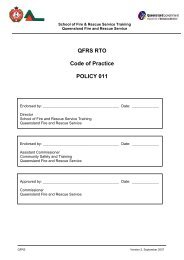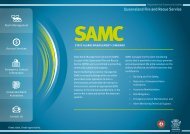QFRS Medical Standards, click here - Queensland Fire and Rescue ...
QFRS Medical Standards, click here - Queensland Fire and Rescue ...
QFRS Medical Standards, click here - Queensland Fire and Rescue ...
You also want an ePaper? Increase the reach of your titles
YUMPU automatically turns print PDFs into web optimized ePapers that Google loves.
Table 1: Oral hypoglycaemic medication - Oral medications<br />
Generic Name<br />
Class<br />
Trade Names<br />
Acarbose<br />
Chlorpropamide<br />
Glibenclamide<br />
Gliclazide<br />
glimepiride<br />
glipizide<br />
Metformin<br />
pioglitazone<br />
rosiglitazone<br />
Toglitazone<br />
Sulfonylurea<br />
Sulfonylurea [LONG ACTING]<br />
Sulfonylurea<br />
Sulfonylurea [LONG ACTING]<br />
Sulfonylurea<br />
Biguanide<br />
Glucobay<br />
Diabinese<br />
Daonil Euglucon Glimel<br />
Diamicron Glyade Nidem<br />
Amaryl Dimirel<br />
Melizide Mellihexal Minidiab<br />
Diabex Diaformin Formet Glucohexal Glucomet Glucophage<br />
Actos<br />
Av<strong>and</strong>ia<br />
List current as at 7 April 2006<br />
6 neurological<br />
6.1 Epileptic Seizures<br />
(a)<br />
(b)<br />
An individual is not fit for duty:<br />
(i)<br />
(ii)<br />
if the person has had one or more epileptic seizures,<br />
however minor, in the past three years; or<br />
if the person is receiving treatment for epileptic<br />
seizures with anti-epileptic drugs, or has received<br />
such treatment within the past three years.<br />
Classification as fit for duty may be considered in the case<br />
of (ii) above if:<br />
(i) a person still being treated with anti-epileptic drugs,<br />
<strong>and</strong><br />
(a)<br />
(b)<br />
(c)<br />
(d)<br />
has had no seizures whatsoever for at least<br />
two years, <strong>and</strong> this fact has been confirmed<br />
in writing by the medical practitioners who have<br />
seen the person at least as often as each three<br />
months, <strong>and</strong><br />
continues to take anti-epileptic drugs in the<br />
prescribed dosage, <strong>and</strong><br />
has been shown to take these drugs reliably by<br />
measurement of their blood concentrations on<br />
several occasions, <strong>and</strong><br />
has an electroencephalogram which, at the<br />
time of consideration, shows no paroxysmal<br />
disturbance.<br />
If such an individual subsequently ceases anti-epileptic drug<br />
therapy on medical advice, his or her activities such as driving shall<br />
be suspended for a 12 month period.<br />
T<strong>here</strong> is a 20% to 30% risk of recurrence, <strong>and</strong> 70% of this risk of<br />
recurrence occurs in the first year after ceasing therapy. Thus after<br />
one year seizure free after therapy, t<strong>here</strong> is less than 10% risk of<br />
another seizure.<br />
(ii)<br />
an individual person who has received anti-epileptic<br />
drugs within the past three years, but no longer does<br />
so, <strong>and</strong><br />
(a)<br />
(b)<br />
Sulfonylurea – risk of hypoglycaemia<br />
was completely free from epileptic seizures for<br />
at least three years before the anti-epileptic<br />
drug therapy was withdrawn;<br />
has had no seizure for a continuous period for<br />
at least 12 months after ceasing drug intake,<br />
(c)<br />
<strong>and</strong> has the supporting opinion of a treating<br />
neurologist; <strong>and</strong><br />
has a recent electroencephalogram which<br />
does not show paroxysmal activity.<br />
Note that excessive fatigue may increase the risk of seizures.<br />
Consideration should be given to the impact of likely shift rosters<br />
prior to permitting a return to duty.<br />
6.2 Cerebro-Vascular Disease<br />
(a)<br />
(b)<br />
An individual is not fit for duty if t<strong>here</strong> has been a<br />
previous cerebral vascular event, (e.g. a stroke due to<br />
cerebral artery occlusion from thrombosis, embolism or<br />
vasospasm, a reversible ischaemic neurological deficit,<br />
a transient ischaemic attack, a cerebral haemorrhage or a<br />
subarachnoid haemorrhage).<br />
Classification as fit for duty may be considered if:<br />
the stroke or subarachnoid haemorrhage had left the<br />
person with no neurological deficit which would<br />
interfere with that persons ability to carry out duties<br />
as a firefighter in a safe <strong>and</strong> efficient manner; <strong>and</strong><br />
the cause of the cerebral vascular event has been<br />
corrected so that the person’s risk of further such<br />
events was no greater than that of a member of the<br />
general population (such a consideration might for<br />
instance apply if a cerebral aneurysm which has<br />
caused a subarachnoid haemorrhage had been<br />
satisfactorily corrected by neurosurgery).<br />
In all cases w<strong>here</strong> consideration is being given for fitness for duty, a<br />
report from the treating specialist (preferred), or general practitioner<br />
should be provided. Please forward any such report to the <strong>QFRS</strong><br />
<strong>Medical</strong> Adviser for review <strong>and</strong> determination of suitability for the<br />
job.<br />
7 respiratory<br />
7.1 Asthma<br />
(a)<br />
(b)<br />
While acknowledging that the diagnosis of asthma<br />
encompasses a wide spectrum of diseases, individuals with<br />
asthma will require careful assessment.<br />
In the course of their duties, firefighters might be exposed<br />
to smoke or other respiratory irritants. In addition, the use<br />
of SCBA may impose an additional burden <strong>and</strong> the cold dry<br />
air might also aggravate respiratory obstruction in those<br />
with hyper-reactive airways.<br />
assessments & medical st<strong>and</strong>ards | www.fire.qld.gov.au<br />
15




